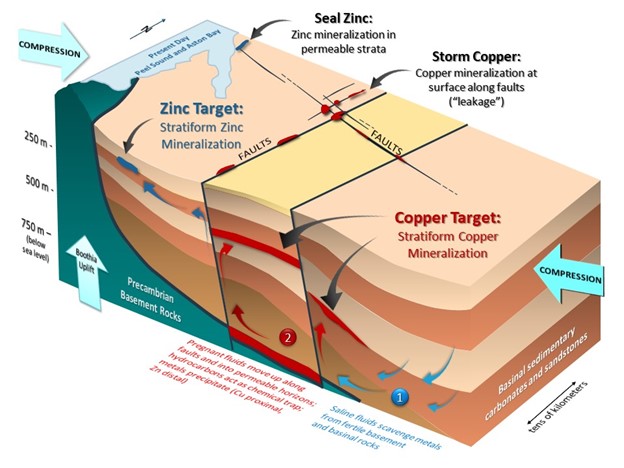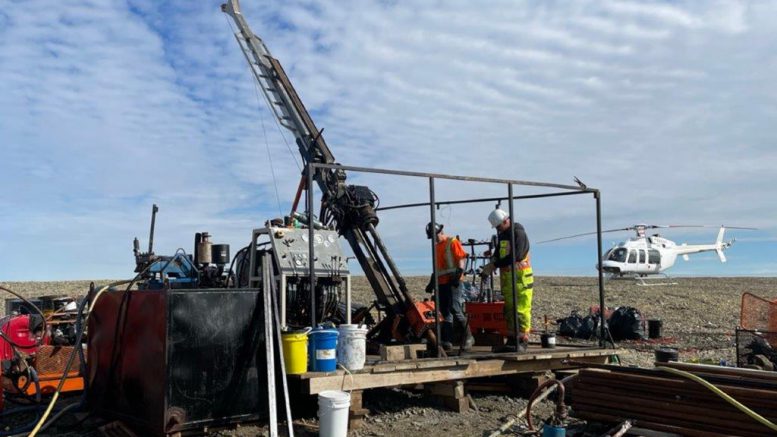Aston Bay Holdings (TSXV: BAY; US-OTC: ATBHF) and American West Metals (ASX: AW1) are betting on new methods to prove the economics of a copper project farther north in Canada’s Arctic than almost anyone has tried.
The Storm copper project, on the Northwest Passage in Nunavut, is early stage with about 6,500 metres drilling and a first resource estimate planned for this year. The aim is to avoid using water, building a deep-water port or leaving tailings on the permafrost, Aston Bay CEO Tom Ullrich said in an interview on Wednesday with The Northern Miner. Processing would be done elsewhere.
“We want to do something completely different and that is use an ore sorting type of operation, a very small footprint with extremely low capital spending,” Ullrich said by phone in Toronto where Aston is based. “We won’t be discharging any water, we won’t have to clean any water, and that will allow us to really compress the permitting timeframe.”
Ore sorting, done by sophisticated sensor technology to increase grades headed for processing, would reduce the footprint and building cost by eliminating the need for a plant with a traditional flotation circuit and tailings facility using millions of litres of water on the frozen tundra. It’s part of an opportunity for project developers to consider environmentally sensitive areas such as the Far North. They can search for green metals to feed the surging demand forecast for transitioning away from fossil fuels while making less of an impact on the local environment than traditional mines.
Storm lies about 200 km south of Canada’s most northerly mine, the Polaris zinc-lead operation run from 1981 to 2002 by Teck Resources’ (TSX: TECK.A, TECK.B; NYSE: TECK) predecessor Cominco, which also used to own Storm and did about 9,000 metres of drilling there. Aston Bay acquired the 4,125-sq.-km site from Commander Resources (CVE: CMD) in 2013 after Cominco let the licences lapse in 2007.
The project on Somerset Island, 112 km south across the passage from Resolute (population 200), is supplied by sea three months of the year and by air to its landing strip. Developing any project so remote has its costs.
“Capital spending in the Arctic is going to be more expensive, but even if it’s $50 million or $100 million, it’s very, very low,” said Ullrich, former chief geologist for North America at Antofagasta (LSE: ANTO). “The thing with the ore sorting is you’d have no sulphide tailings that you’d have to deal with. Wet sulphide tailings are a big problem, particularly in the Arctic.”
Project operator American West, which must spend $10 million on exploration to earn 80% of Storm, is continuing drilling this year after hole ST22-05 last year cut 41 metres grading 4.2% copper from a depth of 38 metres. Surveys show gravity anomalies with strike lengths of several kilometres. The companies want to complete a scoping study to provide rough cost estimates by year’s end.

Diagram of the Storm copper and Seal zinc projects in Nunavut. Credit: Aston Bay Holdings
Drilling of 32 holes at Storm shows 40 hectares of mineralization across four prospects with an average minimal thickness of 24 metres and an average mineralized interval grade of 2.15% copper, American West says on its website.
The shallowness of mineralization probably indicates an open-pit operation, Ullrich said. A test has processed ore to a 54% concentrate. That would be loaded in bulk bags onto barges ashore and pulled to a ship at sea for delivery to a distant plant for more processing. No port would be necessary, the CEO said.
The site is enduring the mucky spring thaw at the moment as it prepares for drilling in July and August of about 4,000 metres using a reverse-circulation unit hauled around by helicopter. As much as 2,000 metres of exploration diamond drilling is also planned, Ullrich said, declining to give costs.
It will probe anomalies found by surveys that are several hundred metres deep and appear to be part of a sedimentary copper system, the CEO said. Drill hole ST22-10 returned 68.8 metres chalcopyrite, pyrite and sphalerite mineralization from 277 metres downhole.
BHP (NYSE: BHP; LSE: BHP; ASX: BHP) entered an earn-in agreement with Aston in 2016 but walked away the next year after about 2,000 metres of drilling, Ullrich said.
According to a deal agreed with Aston in 2021, Perth, Australia-based American West pays for all work until the completion of a feasibility study and production decision. The company owns two projects in Utah.
The West Desert project, about 160 km southwest of Salt Lake City, holds 33.7 million indicated and inferred tonnes grading 3.83% zinc, 0.15% copper and 9.1 grams silver per tonne, according to a February resource filing under Australian Joint Ore Reserve Committee regulations. The early-stage Copper Warrior project is about 420 km southeast of Salt Lake City.
Aston Bay is also exploring two projects in central Virginia, the Buckingham gold vein about 100 km west of Richmond, and the Mountain base metals project south of Lynchburg.
Cominco’s Polaris mine received federal aid such as waived environmental hearings and a government icebreaker to ship out ore processed on a barge. Aston and American West are considering federal grants announced in its recent critical minerals push, Ullrich said.
The property also holds the Seal zinc project which could be explored more and developed after Storm, he said.
“The near-term value really is in the copper here,” the CEO said. “And so we’d like to get at that as quickly as possible.”


Be the first to comment on "Aston sees future in Arctic copper by dropping local processing in favour of ore sorting"